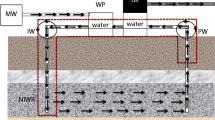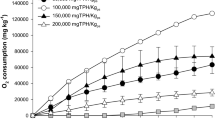Abstract
Two 80-L pond microcosms (laboratory model ecosystems) were treated with the water-soluble fraction of a crude coal liquefaction product and responses were monitored for nine weeks. A large portion of the dominant macrophyte community was destroyed by the treatment, as were filamentous algae and benthic diatoms. Snails emigrated from the systems, and Zooplankton disappeared. Primary production and respiration declined for two weeks, remained low for two more weeks, then gradually returned to pre-treatment levels. Changes occurred in pH, alkalinity, conductivity, dissolved oxygen, dissolved organic carbon, and dissolved inorganic nitrogen. The microcosms recovered by the end of the experiment, but community composition and some chemical variables differed from the pre-treatment conditions.
Similar content being viewed by others
References
Berg, K.: On the oxygen consumption of Ancylidae (Gastropoda) from an ecological point of view. Hydrobiologica4, 225 (1952).
Confer, J. L.: Interrelations among plankton, attached algae, and the phosphorus cycle in artificial open systems. Ecol. Monogr.42, 1 (1972).
Davis, J. C.: Minimal dissolved oxygen requirements of aquatic life with emphasis on Canadian species: a review. J. Fish. Res. Board Can.32, 2295 (1975).
Giddings, J. M., and G. K. Eddlemon: The effects of microcosm size and substrate type on aquatic microcosm behavior and arsenic transport. Arch. Environ. Contam. Toxicol.6, 491 (1977).
—: Photosynthesis/respiration ratios in aquatic microcosms under arsenic stress. Water Air Soil Pollut.9, 207 (1978).
—: Aquatic studies. In W. F. Harris (ed.); Microcosms as potential screening tools for evaluating transport and effects of toxic substances, p. 15. Oak Ridge National Laboratory, Oak Ridge, TN. ORNL/EPA-4 (1980).
Giddings, J. M., B. R. Parkhurst, C. W. Gehrs, and R. E. Millemann: Toxicity of a coal liquefaction product to aquatic organisms. Bull. Environ. Contam. Toxicol.25, 1 (1980).
Giddings, J. M., and J. N. Washington: Coal-liquefaction products, shale oil, and petroleum. Acute toxicity to freshwater algae. Environ. Sci. Technol.15, 106 (1981).
Griest, W. H., D. L. Coffin, and M. R. Guerin: Fossil Fuels Research Matrix Program. Oak Ridge National Laboratory, Oak Ridge, TN. ORNL/TM-7346 (1980).
Guerin, M. R., I. B. Rubin, T. K. Rao, B. R. Clark, and J. L. Epler: Distribution of mutagenic activity in petroleum and petroleum substitutes. Fuel60, 282 (1981).
Hendrix, P. F., C. L. Langner, E. P. Odum, and C. L. Thomas: Microcosms as test systems for the ecological effects of toxic substances: an appraisal with cadmium. U.S. Environmental Protection Agency, Athens, GA. EPA-600/S3-81-036 (1981).
Hutchinson, G. E.: A treatise on limnology. Vol. III. Limnological botany. New York: J. Wiley & Sons (1975).
Keeney, D. R.: The nitrogen cycle in sediment-water systems. J. Environ. Qual.2, 15 (1973).
Leggett, N., D. Britt, T. Williams, M. Subramanian, and M. Parish: Spills from the transportation and storage of coalderived synthetic fuel. Oak Ridge National Laboratory, Oak Ridge, TN. ORNL/TM-7606 (1980).
McConnell, W. J.: Productivity relations in carboy microcosms. Limnol. Oceanogr.7, 335 (1962).
Otsuki, A., and R. G. Wetzel: Calcium and total alkalinity budgets and calcium carbonate precipitation of a small hard-water lake. Arch. Hydrobiol.73, 14 (1974).
Sculthorpe, C. D.: The biology of aquatic vascular plants. London: E. Arnold (1967).
Shaw, D. G., and S. K. Reidy: Chemical and size fractionation of aqueous petroleum dispersions. Environ. Sci. Technol.13, 1259 (1979).
Strand, J. A., III, and B. E. Vaughan: Ecological fate and effects of solvent refined coal (SRC) materials: A status report. Battelle Pacific Northwest Laboratory, Richland, WA. PNL-3819 (1981).
Walton, B. T., M. V. Buchanan, and C.-h. Ho: Comparative embryo-toxicity and teratogenicity of petroleum and petroleum substitutes to insects developing in contaminated sub-strates. In L. H. Keith (ed.): Energy and environmental chemistry. Ann Arbor, MI: Ann Arbor Science (in press).
Wetzel, R. G.: Limnology. Philadelphia: W. B. Saunders (1975).
Woodwell, G. M.: Effects of pollution on the structure and physiology of ecosystems. Science168, 429 (1970).
Author information
Authors and Affiliations
Additional information
By acceptance of this article, the publisher or recipient acknowledges the U.S. Government's right to retain a non-exclusive, royalty-free license in and to any copyright covering the article.
Research sponsored by the Office of Health and Environmental Research, U.S. Department of Energy, under contract W-7405-eng-26 with Union Carbide Corporation. Publication No. 1920, Environmental Sciences Division, ORNL
Rights and permissions
About this article
Cite this article
Giddings, J.M. Effects of the water-soluble fraction of a coal-derived oil on pond microcosms. Arch. Environ. Contam. Toxicol. 11, 735–747 (1982). https://doi.org/10.1007/BF01059162
Received:
Accepted:
Issue Date:
DOI: https://doi.org/10.1007/BF01059162




